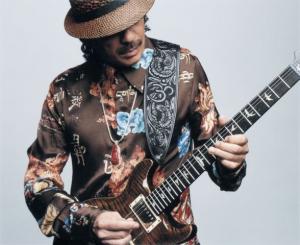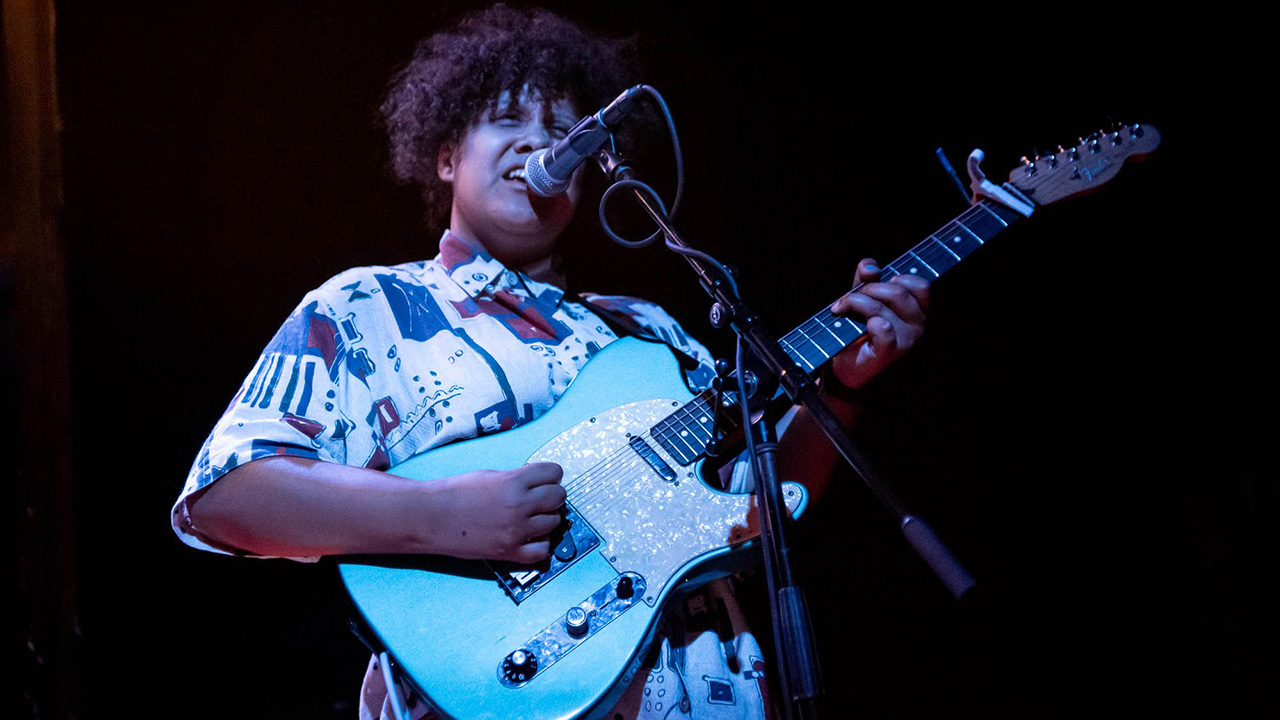Heart of the Matter: Carlos Santana Gets Back to His Roots On 'Corazón,' His New Latin Music Album.

Viva Guadalajara! Viva Santana!
On a recent winter’s evening, the excitement inside the Vincente Gomez Fernández Arena in Guadalajara, Mexico, seemed sufficient to blow the venue’s corrugated tin roof sky high. Backed by his impeccably tight band and joined onstage by a cadre of Latino superstars, a resplendently white-clad Carlos Santana was debuting songs from his new Latin music album, Corazón, in front of what was essentially a hometown crowd.
The iconic guitarist grew up in nearby Autlán de Navarro, making the concert very much a triumphant homecoming for him. But at a pre-show press conference, Carlos made it clear that, for him, the evening held an even larger meaning.
“I honor being Mexican and being born here,” he said. “But I don’t have the feeling that that’s all I am. I am all the animals in the zoo. I identify with Paris and San Francisco. I identify with Bob Marley and Michael Jackson. And of all the artists at Woodstock, some of them are not here anymore. But I’m here, and I’m ready to take it to a whole other level.”
At Woodstock in 1969 and throughout the early Seventies, Santana revolutionized the sound and scope of rock music by fusing the passionate intensity of Latin rhythms with the white-hot rock guitar aesthetic that players like Jeff Beck, Jimi Hendrix, Eric Clapton and Jimmy Page had recently brought to the music’s foreground. Santana actually had to fight to get the Spanish-language tune “Oye Como Va” onto his classic 1970 album Abraxas. (The song went on to become a hit for his group.)
In that respect, Corazón is a beautiful barometer of how far things have come since then. With the exception of Bob Marley’s “Iron, Lion, Zion,” sung in Jamaican/English patois by Ziggy Marley, all the songs on the album are performed in either Spanish or Portuguese by an all-star cast of guest vocalists. They include veterans like Gloria Estefan and young bloods like Juanes, who was originally with the Colombian metal band Ekymosis, and Samuel Rosa of the Brazilian ska group Skank.
- But in many ways, the real language of Corazón is that of the guitar—not to mention the heart, which is what the title means in Spanish. Santana’s always-fiery playing hits a new caloric level on the disc. His deep connection to this music can be felt in every note.
- “Let’s not forget, man, California’s in a serious drought now,” he deadpans. “So we need some seriously juicy notes.”
Given the current dry emphasis on scales and technique in rock guitar playing, Corazón is indeed like a tall, refreshing glass of fresh mango juice, spiked perhaps with a little of Carlos’ favorite tequila. Rock guitarists of the Seventies had a lot to learn from early Santana game changers like Abraxas, Caravansari and Love Devotion Surrender. In the same way, today’s guitarists can cop a few lessons from Corazón.
Get The Pick Newsletter
All the latest guitar news, interviews, lessons, reviews, deals and more, direct to your inbox!
“I love all the young players today,” Carlos rhapsodizes. “I love my sister Orianthi and this new lady Desiree Bassett, who’s playing on the Michael Jackson Cirque du Soleil tour right now. And this young gentleman Quinn Sullivan, who’s playing with Buddy Guy. I welcome all that, man. And hopefully they can hang around me so they can—ready for this?—expand their portfolio. Latino music is really a combination of music from Africa, Spain and Germany: polkas, waltzes, flamenco and a whole lot of African music. We Latinos didn’t invent it; we integrated it.”
While reconnecting Santana with his Latino heart, Corazón also brought him back together with the amp that created much of his classic Seventies tone: his snakeskin Mesa/Boogie Mark I, originally given to him by his guitar-playing brother, Jorge, in 1973.
“I stopped playing it for a while,” he says, “I don’t know why. But then I just rediscovered it last year when somebody sent me a video of Santana at the Budokan in Japan in 1973. And I said, ‘Oh my god, I gotta get back to that sound! It’s like an old friend that I miss like crazy.” And sure enough, we found the amp in the warehouse, and we sent it to Randy [Mesa/Boogie chief Randall Smith]. They cleaned it up a bit, took a little bit of the rust away. Man, that amp’s sound is supreme for blues and everything else.”
For the Corazón sessions, Santana teamed his Boogie with a Dumble amp and a Bludotone Universal Tone head. “Those three give me the head tones, chest tones and bass tones,” he notes. “I use three amps not to be louder but to be correct with the three dimensions of highs, middles and lows.”
Plugged into these amps, most of the time, were two salmon-colored PRS custom Santana model guitars: one with a Brazilian rosewood fingerboard from 2006 and another with an Indian rosewood fingerboard from 2013. The latter guitar was made for a tour of Europe, where there’s a ban on Brazilian rosewood, an endangered tonewood. The Indian rosewood yields a slightly brighter tone, according to longtime Santana guitar tech Ed Adair. The guitar from ’06 is called Salmon, and the ’13 model Son of Salmon.
“Those two are the main quarterbacks,” Carlos says. “Although once in a while I play some of the other PRS guitars I have. Anything Paul Reed Smith sends is incredible. So I played 90 percent PRS on the album and 10 percent Strat.”
The Stratocaster in question is an ash-bodied, maple-necked hybrid assembled from parts at Cowtown Guitars in Las Vegas. It’s heard on Corazón’s first single release, “La Flaca,” sung by Juanes, and “I Am the Light,” which features Santana’s longtime musical comrade saxophonist Wayne Shorter.
As has been the case for some time now, Carlos sticks strictly to lead guitar on Corazón. Rhythm guitar duties are deputized to Tommy Anthony and Tim Pierce, who ace everything from the Latin-goes-ska vibe of “Saideira” to the sultry drive of “La Flaca.”
“I feel like I need a rhythm guitar player around me,” Carlos says, “so I can really concentrate on ‘O Solo Mio.’ Just take solos, you know? And trust that somebody else can direct the grooves. Some of the greatest guitarists were really solid rhythm players, like Steve Cropper, Freddie Green, Freddie Stone with Sly & the Family Stone, and Al McKay with the Watts 103rd Street Rhythm Band. There’s an art to playing rhythm guitar in such a way that there’s an incredible groove in the room. That’s important to me. At this point, I’m 67, surrounded by a band that has a lot of energy, and I’m really grateful for that.”
Corazón also gave Carlos an opportunity to pay tribute to one of his key Latin American guitar heroes, the late Brazilian jazz great Bola Sete.
“I once sent a couple of Bola Sete CDs to Paco de Lucía, John Scofield and John McLaughlin,” Santana says. “Because to me, Bola Sete was at the same level as Andrés Segovia, Charlie Christian, T-Bone Walker, Wes Montgomery and Jimi Hendrix. There’s a video you can find on YouTube of Bola Sete playing with Wes Montgomery. The guy’s grinning the whole time. Never even looks down at the guitar and he’s kicking your ass. Just pure beauty, grace, brilliance and excellence. His guitar don’t even have dots or anything. He’s playing bass with his thumb and lead and rhythm with his two fingers. So I got a chance to do one of his songs on this album. It’s called "I See Your Face.”
Carlos busts a few nylon-string moves of his own on “Una Noche en Nápoles,” laying licks alongside three queens of Latina song—Lila Downs (Mexico), Nina Pastori (Spain) and Soledad Pastorutti (Argentina)—who imbue each verse with an escalating sense of sensuous drama before nailing your heart to the door in three-part harmony choruses. Carlos rises to the occasion on a 1962 José Ramírez flamenco nylon-string backed by a 1972 Martin D12-20 12-string that once belonged to Eric Clapton. Both were loaned for the session by Pete Trauth of AJ’s Music in Las Vegas.
“I played nylon strings on and off in Mexico when I was growing up,” Carlos recalls, “because I didn’t know you were supposed to have steel strings to make the guitar electric. So even when I had an electric guitar, I put nylon strings on it. And I’d say, ‘I can’t get any volume out of this!’ Until someone said, ‘That’s because you’re not playing with steel strings!’ Oh man, I was just a kid.”
For Latin music veterans and newcomers alike, working with Carlos Santana means stepping up to the plate in a big way. The faint of heart need not apply. But how does he know if the chemistry is right?
“I look in their eyes,” he says, “and I know if it’s ready or not. If it’s not ready, we can’t go there, because velocity and luminosity have to be in the room. It can’t be ‘kinda, sorta, maybe.’ I don’t want to be around those words. I can’t hang with ‘to be or not to be’—all that self-doubting, dry intellectual stuff. That’s okay for Shakespeare, but I’d rather hang with Albert King, Albert Collins and Stevie Ray Vaughan. Those guys didn’t know words like kinda, sorta, maybe or to be or not to be. Just it is!”
In a career that spans five decades, Alan di Perna has written for pretty much every magazine in the world with the word “guitar” in its title, as well as other prestigious outlets such as Rolling Stone, Billboard, Creem, Player, Classic Rock, Musician, Future Music, Keyboard, grammy.com and reverb.com. He is author of Guitar Masters: Intimate Portraits, Green Day: The Ultimate Unauthorized History and co-author of Play It Loud: An Epic History of the Sound Style and Revolution of the Electric Guitar. The latter became the inspiration for the Metropolitan Museum of Art/Rock and Roll Hall of Fame exhibition “Play It Loud: Instruments of Rock and Roll.” As a professional guitarist/keyboardist/multi-instrumentalist, Alan has worked with recording artists Brianna Lea Pruett, Fawn Wood, Brenda McMorrow, Sat Kartar and Shox Lumania.











